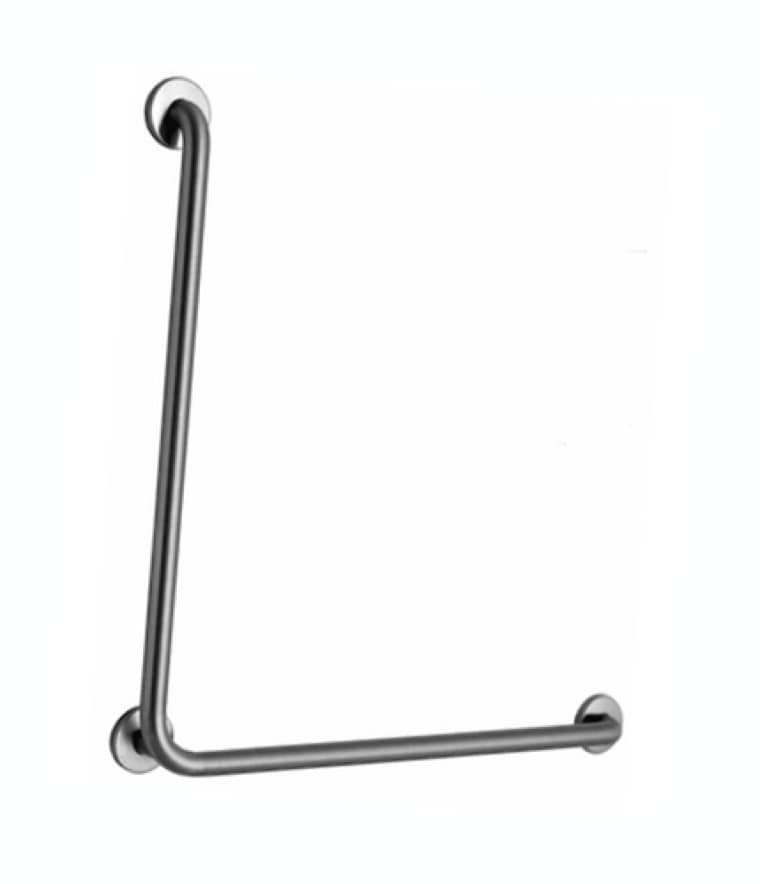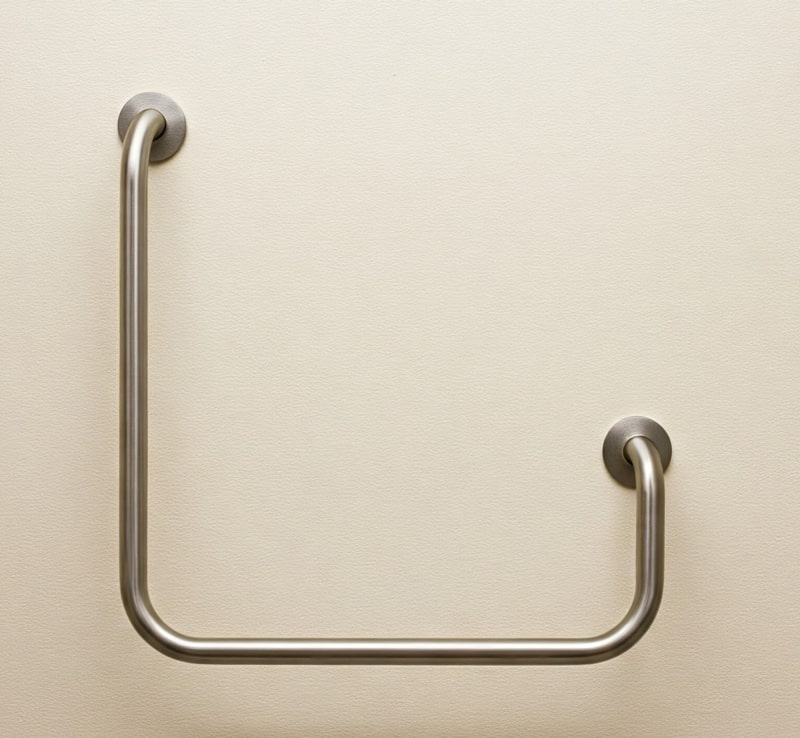Best Places to Install Grab Bars in Commercial Washrooms
Posted by Handy Washroom on Jan 23rd 2025
 Many business owners recognize the importance of accessible design, and invest in sturdy fixtures for their washrooms, that meet regulatory standards.
Many business owners recognize the importance of accessible design, and invest in sturdy fixtures for their washrooms, that meet regulatory standards.
These fixtures are meant to keep employees and visitors safe, and cater to diverse mobility needs. They also reduce potential liability issues, and they demonstrate a company’s commitment to inclusivity.
One important fixture are grab bars, and this article covers the best places to install them in commercial washrooms, and it outlines the practical methods for increasing user confidence.
The Need for Grab Bars in Wash and Rest Rooms
A comprehensive grasp of washroom safety begins with the correct use of bathroom grab bars.
These bars anchor to the walls at strategic points, and they help individuals maintain balance when floors become slick or if they have general mobility issues.
They can accommodate a range of mobility challenges, and they create a reassuring fixture for anyone who feels unsteady.
Compliance with accessibility guidelines also enhances your brand reputation, and it promotes a welcoming environment for all visitors.
Here are the key fixtures needed for a commercial restroom and the key factors that go into a universal washroom.
To Reduce Common Slip Hazards
High-traffic washrooms in facilities like gyms, hotels, and hospitals often face higher risks of slips. Water from shower stalls or hand-washing areas accumulates on the floor, and reduces traction for unsuspecting users.
A sturdy grab bar would serve as a preventive measure that people can rely on when they move across these zones because it allows them to brace themselves securely, and it prevents sudden falls that lead to injuries.
Common slip hazards are:
- Standing water from showers or sinks.
- Dripping mop heads or wet cleaning supplies.
- Residue from soaps or cleaning agents.
To Maintain Code Compliance
Local regulations typically dictate the height and placement of grab bars, and they address specific wall reinforcement needs.
A properly installed grab bar helps your commercial space meet these codes and pass inspections without complication.
Facilities that ignore such guidelines run the risk of expensive legal issues - especially if there's an injury - and losing credibility with clients. Responsible operators happily follow these rules diligently to protect both their patrons and their reputation.
List of code compliance requirements:
- Specific height and spacing guidelines.
- Minimum weight capacity for each bar.
- Wall stud or backing recommendations for secure installation.
- Requirements for easy access in wheelchairs or with walkers.
With a clear sense of why grab bars matter, you can explore specific placement options that suit commercial shower stalls.
Vertical Grab Bars for Targeted Stability
 Vertical grab bars in commercial washrooms concentrate support in compact spaces, and they help users achieve a firm grip when needed.
Vertical grab bars in commercial washrooms concentrate support in compact spaces, and they help users achieve a firm grip when needed.
These bars often appear near entrances to showers or changing areas, and they align with studs or reinforced sections of the wall so they can handle heavy weight.
They can accommodate different arm lengths, and they aid users who need immediate assistance when stepping over raised edges. The following points highlight why vertical orientation complements various washroom layouts.
They Provide Entry Point Assistance
A vertical grab bar near the shower entrance helps people steady themselves when they cross wet thresholds. This positioning ensures that individuals have something secure to hold the moment they step inside. It can also reduce congestion in busy locker rooms by directing traffic flow more safely.
Maintenance staff appreciate how these bars simplify cleaning tasks, and statistically, managers note fewer slip-related incidents.
Participants who had a grab bar were 75.8% more likely to recover their balance during the task than those who did not have a grab bar. [source]
Ease of Use for All Heights
Patrons vary in height and stature, so a vertically aligned grab bar is installed to cover a greater vertical range.
This ensures that tall or shorter individuals can locate a comfortable grip zone.
As you consider vertical options, remember that horizontal bars also provide vital stability across broader spans.
Once you understand vertical placements, you can explore how horizontal bars benefit commercial settings.
Horizontal Grab Bars in Larger Stall Areas
 Horizontal grab bars span a wider portion of the wall, and offer continual support along the length of the shower or washroom stall.
Horizontal grab bars span a wider portion of the wall, and offer continual support along the length of the shower or washroom stall.
They differ from vertical bars because they address the need for lateral balance rather than strictly vertical assistance.
Many commercial washrooms include wide stalls to accommodate wheelchairs or walkers, and horizontal bars enhance safe transfers.
Horizontal bars create an ergonomic solution that helps people feel secure when they manoeuvre within a larger space.
They Provide Waist-Level Reinforcement
A bar installed at waist level allows users to brace themselves while reaching for toiletries or adjusting water temperatures. It can help them maintain an upright posture, and it keeps them stable in slippery surroundings.
Facility managers often align these bars with soap dispensers or bench seats to promote more efficient and easier movement.
Visitors of different abilities benefit from this setup, and they gain peace of mind during each use.
They Support Across Multiple Points
In larger stalls, two horizontal bars at different heights offer more gripping options. One bar can sit higher for standing users, and the other bar accommodates those who need lower support.
This configuration caters to a broad spectrum of physical requirements, and it fosters an inclusive environment.
Having multiple support points boosts user confidence, and it encourages them to move freely within the stall.
Installing horizontal grab bars sets the stage for a comprehensive washroom upgrade.
Strategies for a Complete Washroom Upgrade
Operators who prioritize accessibility often adopt multiple grab bar styles to meet a range of user preferences. They strengthen their walls to accommodate the necessary fixtures, and they invest in durable stainless steel or corrosion-resistant materials.
Proper planning involves measuring available space accurately, and it considers feedback from employees and patrons.
The following suggestions help managers finalize their upgrades and maintain a safe, welcoming environment.
Hire Qualified Professionals
A contractor familiar with commercial codes knows the optimal placement for grab bars, and they can easily identify reliable wall studs.
They verify that each bar remains secure under repeated use, and that they adhere to mandated height regulations.
An experienced installer ensures that no guesswork undermines your washroom’s safety and their expertise will ultimately save you time, and safeguard your building’s reputation.
Incorporating Extra Safety Features
Commercial washrooms benefit from as many safety features as possible.
Some extra features can include:
- Floor-to-ceiling solutions such as anti-slip flooring and adequate drainage.
- Clear signage to direct visitors to accessible stalls and reduce crowding.
- Wall-mounted seats and hand-held shower heads to support individuals with limited mobility.
- Improved lighting with motion sensors.
When it comes to public and commercial washrooms, the goal is to apply thoughtful design with robust materials, and professional insight to create a reliable space that respects every user’s needs.
